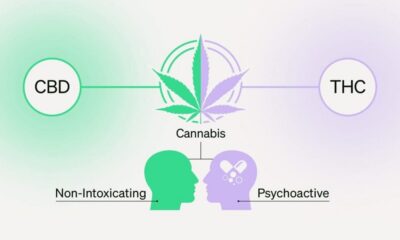Business
The Best Weekend Part-Time Job To Consider & How You Can Apply For Them

If you are looking for some extra income or a flexible work schedule, you might want to consider taking up a weekend part-time job. There are many benefits of working part-time, such as having more free time, gaining new skills, meeting new people, and saving on commuting costs.
But how do you find a suitable weekend part-time job in Singapore?
One of the easiest ways is to use an online job portal Singapore job search sites like JobMaster, where you can filter by hourly pay and the part-time job vacancy positions to choose from. You can also browse through different categories of jobs, such as retail, food and beverage, education, customer service, and more.
To help you get started, here are for of the most sought-after part-time jobs that can be done on the weekends in Singapore that pay quite well.
Service Crew
If you enjoy interacting with customers and serving food and drinks, you might want to work as a service crew at a restaurant, cafe, or kiosk. You will be responsible for taking orders, preparing food and beverages, clearing tables, and ensuring customer satisfaction. You will also learn how to handle cash and operate point-of-sale systems.
The average hourly pay for a service crew in Singapore is $9.50, but some places may offer higher rates or incentives. For example, Boost Juice Bars offer up to $9 an hour for part-time service crew, while Kulture Studios offers $8 to $15 an hour for fitness studio member experience concierge.
To apply for a service crew job, you will need to have good communication skills, a positive attitude, and a willingness to learn. You may also need to have a food hygiene certificate or undergo training before you start working.
Retail Assistant
If you have a passion for fashion, beauty, or lifestyle products, you might want to work as a retail assistant at a mall or a boutique. You will be responsible for greeting customers, recommending products, handling transactions, arranging merchandise displays, and maintaining store cleanliness. You will also learn how to provide excellent customer service and sales skills.
The average hourly pay for a retail assistant in Singapore is $9.30, but some places may offer higher rates or commissions. For example, MM SG Retail offers an attractive remuneration package for part-time sales associates, while Pathlight School offers temporary retail assistant jobs.
To apply for a retail assistant job, you will need to have good communication skills, a friendly personality, and a keen interest in the products you are selling. You may also need to have some relevant experience or undergo training before you start working.
Tutor
If you have a knack for teaching and sharing knowledge, you might want to work as a tutor at an enrichment centre or a private home. You will be responsible for preparing lesson plans, teaching students according to their levels and needs, marking assignments, and providing feedback. You will also learn how to manage classroom behaviour and motivate students.
The average hourly pay for a tutor in Singapore is $25, but some places may offer higher rates or bonuses. For example, Writers @ Work Enrichment Centre offers $45 to $60 an hour for a part-time English teacher, while Think Academy International Education offers $15 an hour for a centre administrator.
To apply for a tutor job, you will need to have good academic qualifications, teaching experience or certification, and a passion for education. You may also need to have a relevant subject specialisation or undergo training before you start working.
We will explore the pros and cons of social media todayenvironmentnews is a place where you can get Latest Worldwide News.
Admin Assistant
If you are organised and detail-oriented, you might want to work as an admin assistant at an office or a home-based setting. You will be responsible for performing clerical tasks such as data entry, filing documents, answering phone calls and emails, scheduling appointments, and supporting other staff members. You will also learn how to use various software applications and office equipment.
The average hourly pay for an admin assistant in Singapore is $10, but some places may offer higher rates or benefits. For example,
Struers Aps Singapore Branch offers part-time admin assistant jobs, while E-Job Pte Ltd offers up to $2,300 a month for full-time or part-time admin assistant jobs.
To apply for an admin assistant job, you will need to have good communication skills, computer literacy and a sense of responsibility. You may also need to have some relevant experience or undergo training before you start working.
Working a part-time job can be a great way to earn some extra money and gain new experiences. Whether you’re looking for something flexible or would like to delve into a new career field, there are plenty of weekend part-time job that might suit your needs! Take the time to research the possibilities and figure out how you can apply for them on the many job portals in Singapore so that you can start working soon!
Business
How Does the RapidWorkers Site Work to Earn Money?

Earning money online has become a global trend, but many people are unsure where to start. Traditional freelancing often demands specialized skills, a strong portfolio, and significant time investment. On the other hand, survey sites and “get-rich-quick” platforms frequently disappoint with low payouts or questionable legitimacy.
This is where rapid workers steps in. Rapidworkers is a micro-task site designed to connect businesses that need small online jobs completed with individuals willing to perform them for pay. If you’ve ever wondered how RapidWorkers makes money, this article will walk you through the challenges it solves, strategies to maximize your earnings, the benefits of the platform, and tools that can help you succeed.
The Problem: Why Making Money Online Feels Overwhelming
For most people, earning money online presents several challenges:
- High skill barriers: Many freelance platforms favor those with technical expertise in design, coding, or copywriting.
- Long turnaround times: Larger projects often require days or weeks to complete before payment.
- Unclear payment terms: Some sites delay or fail to pay workers.
- Limited global access: Certain platforms restrict opportunities to specific regions.
For example, a study by Statista shows that while digital gig work is growing rapidly worldwide, many entry-level workers feel excluded due to a lack of experience. This creates demand for a platform that provides fast, simple, and legitimate micro-income opportunities, exactly what Rapidworkers offers.
Getting Started With Rapidworkers
Starting with Rapidworkers is simple and quick. You only need a few steps to begin earning money by completing small tasks online. These tasks are easy and do not require special skills. The site connects workers with employers who need small jobs done.
This section shows how to create your account and set up your profile. Both steps are important to get started and to receive tasks that match your skills.
Creating An Account
Go to the Rapidworkers website and find the sign-up button. Fill in your email, username, and password. Use a valid email because you will need to confirm it. After registering, check your email for a confirmation message. Click the link in that email to activate your account. Once activated, you can log in and start working.
Setting Up Your Profile
After creating your account, set up your profile. Add your full name and country. This helps employers know who they are hiring. Upload a clear profile picture if possible. Write a short description about yourself. Mention any skills or experience you have. A complete profile increases your chances of getting tasks. Keep your profile honest and updated. This builds trust with employers and helps you earn more.
Types Of Tasks Available
The Rapidworkers site offers many types of tasks to earn money. Each task is simple and quick. This variety helps workers find tasks that suit their skills and time. Understanding the types of tasks can help you choose the best way to earn.
Micro Tasks Overview
Micro tasks are small jobs that take just a few minutes. They often need little training or special skills. These tasks include clicking, watching videos, or filling out surveys. Each completed task earns a small payment. Doing many micro tasks can add up to a good income.
Popular Task Categories
Some common task categories stand out on Rapidworkers. Data entry jobs ask you to input or check information. Social media tasks include liking posts or following accounts. Website testing tasks ask for feedback on websites or apps. Surveys gather opinions on products or services. These categories offer many chances to earn money quickly.
How To Choose Tasks
Choosing the right tasks on Rapidworkers can help you earn money faster. The site offers many tasks, but not all tasks pay the same or take the same time. Picking tasks carefully saves your time and increases your earnings.
Focus on tasks that match your skills and pay well. Avoid tasks that seem too hard or pay very little. Use the site tools to filter and select tasks smartly.
Filtering Tasks By Difficulty
Rapidworkers lets you filter tasks by difficulty. Easy tasks take less time but may pay less. Hard tasks might pay more but need more effort. Choose tasks that suit your skill level. This helps you finish tasks quickly and avoid mistakes.
Selecting High-paying Tasks
High-paying tasks offer better rewards for your time. Look for tasks with clear instructions and good ratings. Avoid tasks that seem suspicious or have low pay. Prioritize tasks that pay more for less work. This strategy helps you earn more in less time.
Completing Tasks Effectively
Completing tasks effectively on Rapidworkers is key to earning steady money. Each task demands attention to detail and meeting specific instructions. This helps avoid rejections and saves time.
Understanding the task well leads to faster approval and more earnings. Focus on accuracy and follow the rules closely. Small mistakes can cause delays or loss of payment.
Task Requirements And Guidelines
Every task on Rapidworkers comes with clear requirements. Read them carefully before starting. They explain what you must do and how to submit your work.
Some tasks need screenshots as proof. Others require filling out forms or clicking links. Follow all instructions exactly to get paid.
Ignore extra steps that are not listed. Stick to the task scope to avoid rejection. Check the deadline and finish on time.
Tips For Fast And Accurate Completion
Focus on one task at a time. This reduces errors and speeds up work. Use a checklist to track steps for each task.
Double-check your answers or uploads before submission. Correct mistakes early to prevent delays. Stay organized to handle multiple tasks smoothly.
Use a stable internet connection to avoid interruptions. Save your work regularly. This keeps progress safe and helps meet deadlines.
Payment Methods And Payouts
Understanding payment methods and payouts on Rapidworkers is essential for users who want to earn money effectively. This section explains how you can receive your earnings, the minimum amount needed to withdraw, and the time it takes to get paid. Clear knowledge about these aspects helps you plan your tasks better and avoid surprises.
Available Payment Options
Rapidworkers offers several ways to get paid. The most common option is PayPal, a secure and widely used platform. You can also choose payment via Payoneer, which is popular for international users. Some users prefer gift cards, which Rapidworkers occasionally provides. These choices give flexibility to users worldwide.
Minimum Withdrawal Limits
Before requesting a payout, you must reach a minimum balance. Rapidworkers sets this limit at $10. This amount is easy to achieve by completing small tasks. Keeping track of your earnings helps you know when you can withdraw money. Reaching the limit quickly encourages steady task completion.
Payment Processing Times
After you request a payout, Rapidworkers processes payments within 3 to 5 days. This time frame depends on the payment method you choose. PayPal payments usually arrive faster than other options. Being aware of processing times helps you manage your expectations.
Maximizing Earnings On Rapidworkers
Maximizing earnings on Rapidworkers requires a smart approach. Consistency and wise task choices can boost your income. Understanding the referral program adds another income source. Focus on strategies that fit your time and skills. Small efforts each day add up quickly.
Consistency And Task Selection
Regular activity on Rapidworkers helps maintain steady earnings. Check the site daily to find new tasks. Choose tasks you can complete fast and well. Simple tasks often pay less but take less time. Complex tasks may pay more but need more effort. Balance your time and task difficulty for the best results. Avoid tasks that seem unclear or risky. Staying active and selective leads to steady income growth.
Referral Program Benefits
Rapidworkers offers a referral program to increase your earnings. Invite friends to join and earn a percentage of their income. This creates a passive income stream alongside your tasks. Share your referral link in places where people trust you. Explain the benefits of joining Rapidworkers to your referrals. The more active your referrals are, the more you earn. Use the referral program as a long-term earning strategy.
Common Challenges And Solutions
Using Rapidworkers to earn money has some challenges. Knowing these helps avoid problems. Simple solutions keep your account safe and earnings steady.
Avoiding Task Rejections
Task rejections reduce your earnings and lower your rating. Read each task’s instructions carefully before starting. Follow every step exactly as asked.
Check your work for mistakes before submitting. Double-check links, answers, and any required proof. Submit clear screenshots if needed. This helps show you completed the task correctly.
Do not rush tasks. Taking time improves accuracy and lowers rejection chances. If unsure about a task, skip it. Choose tasks you understand well.
Dealing With Account Issues
Account problems can stop your earnings. Keep your login details safe and private. Use a strong password and change it regularly.
Verify your email and profile information fully. Incomplete profiles may cause delays or restrictions. Contact Rapidworkers support quickly if you face issues.
Stay polite and clear in your messages to support. Provide all requested details to speed up help. Avoid using multiple accounts to prevent bans.
User Experiences And Reviews
User experiences and reviews reveal how Rapidworkers helps people earn money. Many users share their personal stories and challenges. These insights show what to expect from the site. Reading real feedback helps new users decide if it suits them.
Success Stories
Some users report steady earnings from simple tasks. They praise the easy signup process and fast task completion. Many mention receiving payments on time without hassle. For some, Rapidworkers became a small but consistent income source. Success often depends on task availability and user effort.
Potential Drawbacks
Some users face low pay rates for certain tasks. A few mention waiting longer to reach the minimum payout. Task quality can vary, with some feeling repetitive or dull. Occasional account restrictions have affected a small number of users. Patience and careful task selection can reduce these issues.
Frequently Asked Questions
What Is Rapidworkers, And How Does It Pay?
Rapidworkers is a micro-task website that pays users for completing small online jobs. Payments are made via PayPal or other supported methods once tasks are verified and approved. Users earn money by performing simple tasks like surveys, app downloads, and data entry.
How Do I Start Earning Money On Rapidworkers?
To start earning, sign up for a free account on Rapidworkers. Browse available tasks and complete those that match your skills. Submit proof of task completion for approval. Earnings accumulate in your account and can be withdrawn after reaching the minimum payout threshold.
Are Rapidworkers Tasks Easy And Quick To Complete?
Yes, most Rapidworkers tasks are designed to be simple and fast. Tasks typically take a few minutes each, such as watching videos, signing up for websites, or sharing content. This allows users to earn money steadily by completing multiple tasks daily.
Is Rapidworkers A Legitimate Site For Earning Money?
Rapidworkers is generally considered legitimate as it has paid thousands of users worldwide. However, earnings may be modest, and task availability varies. Always be cautious and avoid tasks requiring sensitive personal information to protect your privacy and security.
Conclusion
Making money online doesn’t have to be complicated. With Rapidworkers, you can start earning by completing simple micro-tasks, even if you have no advanced skills or prior freelancing experience. The platform is reliable, easy to use, and designed for both businesses seeking quick online engagement and individuals looking for flexible income opportunities.
Business
Why More Indian Start-ups Prefer Business Setup Dubai UAE for Expansion

When Indian start-ups think about moving beyond home ground, Dubai usually comes up early in the discussion. It is nearby, easy to reach, and already familiar to many because of trade links and travel. The city is more than just a stopover; it has become a natural choice for businesses that want to take their next step abroad.
And when people talk about business setup Dubai UAE, they are not just thinking about tall towers or global offices. They are looking at a system that actually supports registration and growth.
Why Start-ups Look at Dubai?
There are a few reasons why young companies from India keep choosing a business setup in Dubai. The city connects East and West, offers multiple free zones, and has a large base of international clients. For a founder sitting in Mumbai, Bengaluru, or Delhi, Dubai feels both global and accessible at the same time.
But moving into a new country also means working with a framework that is not the same as India’s. Licences, approvals, and banking processes are all part of the deal. This is where guidance becomes essential; otherwise, time and energy get wasted in figuring things out.
Role of Consultants in Setup
A business set up consultant in Dubai is often the first call many founders make once they decide to expand. Why? Because the consultant already knows the route. Instead of trial and error, the process gets mapped clearly.
Think of a start-up founder trying to choose between a mainland entity and a free zone option. On paper, both look fine. In practice, the decision affects ownership, office space, and future expansion. Consultants break down these differences in simple terms and help the founder decide what fits best.
Typical areas where consultants step in:
- Choosing between the free zone, the mainland, and the offshore.
- Preparing and checking incorporation documents.
- Coordinating with different authorities for faster approvals.
- Helping with bank account formalities and visa applications.
For a start-up, this support means less time wasted on queues and more time spent on product and customers.
Business Setup Services in Dubai
The range of business setup services in Dubai goes beyond just forming a company. Many service providers handle the after-work as well.
That includes:
- Drafting legal papers
- Translation and attestation support
- Tax and compliance guidance
- PRO services for routine submissions
- Options for shared or private office space
Indian entrepreneurs, who may have spent weeks dealing with red tape back home, often find this system far simpler when handled by professionals.
Dubai vs Other Emirates
When talking about business setup in UAE, start-ups do look at other Emirates like Sharjah or Ras Al Khaimah. Each has its advantages. Some are more cost-effective, others may focus on specific industries.
Even so, Dubai continues to attract the majority because of its ecosystem. Free zones designed for technology, retail, and logistics, combined with global exposure, make it the preferred spot. Consultants working with business setup companies in Dubai usually help founders compare these options before finalising.
Why is the Trend Growing?
The real reason behind the shift is not just opportunity but also ease. Founders feel they can rely on business setup companies in Dubai to take care of the background work. This gives them confidence to enter a new market without worrying about missing forms or unclear rules.
Over the last few years, the pattern has been the same: more Indian start-ups, especially in services and technology, have looked at business setup in Dubai UAE, as their first international move.
Conclusion
For start-ups in India, global expansion does not have to mean moving too far. Dubai offers a mix of opportunities, location, and systems that make it attractive. With the help of a business set up consultant in Dubai and specialised business setup services in Dubai, entrepreneurs can focus on scaling instead of stressing about paperwork.
That is why business setup Dubai UAE continues to grow as a trend among Indian start-ups; it offers accessibility and clarity at a stage when both matter the most.
Business
Benefits of Using Business Setup Companies in Dubai for Hassle-Free Registration

For many Indian entrepreneurs, Dubai is often the first place that comes to mind when thinking about starting a company abroad. It is close to India, well-connected, and offers plenty of opportunities. But once the excitement of planning is over, the reality of setting up can feel heavy.
There are forms, approvals, and rules that don’t always look straightforward. That is why people prefer to get help from business setup companies in Dubai, instead of trying to figure it all out alone.
What Business Setup in Dubai Really Means?
Starting a company in Dubai is not just filling a form and opening the doors. A proper business setup in Dubai usually means:
- Deciding if the company should be in the mainland, free zone, or offshore
- Getting the right licence for the type of activity
- Preparing official documents and ensuring they are accepted
- Opening a bank account that suits business use
- Handling visas for employees and partners
For someone used to the Indian system, the process feels different. Even simple approvals may need local knowledge. That is why guidance becomes valuable.
Why Consultants Make Life Easier?
A business set up consultant in Dubai is someone who knows which approvals go where and in what order. Instead of running around from one office to another, you get a clear path.
Think of it this way: if you were to renovate your home in India, you could do it yourself, but most people call a contractor. The contractor knows the sequence of work, arranges skilled people, and makes sure things don’t get delayed. In a similar way, a consultant handles the registration process.
How they usually help:
- Explaining which structure (mainland or free zone) fits your plan.
- Taking care of paperwork in the correct format.
- Following up with departments so approvals don’t get stuck.
- Give reminders for compliance, so you don’t miss timelines.
Services Offered by Setup Companies
Most business setup services in Dubai do not stop at registration. They also look after day-to-day support, such as:
- Preparing incorporation documents and getting them notarised
- Helping in opening a business account in a local bank
- Coordinating visa applications for you and your staff
- Advising on tax registration as per the rules
- Offering PRO support for routine government paperwork
This saves entrepreneurs from being pulled into details that can take up weeks.
Looking Beyond Dubai
While Dubai is the most popular choice, the wider UAE has several other options. Abu Dhabi, Sharjah, and Ras Al Khaimah each have their free zones and benefits. Choosing between them is not easy unless you know the differences. Consultants working with business setup Dubai UAE often compare costs, ownership rules, and industry focus, and then guide you on which option fits best.
Real Effort Saved
The real benefit is visible when you see how much effort is avoided. Without consultants, entrepreneurs may spend days visiting different counters. With consultants, the same work is done with fewer delays.
- Bank account procedures are appropriately managed.
- Visa applications are less stressful.
- Government communication is handled by someone who knows the system.
- Legal translations and certifications don’t become last-minute problems.
This is why many Indian entrepreneurs say that hiring a consultant feels like having a local partner.
Picking the Right Company
There are many business setup companies in Dubai, but not all provide the same level of service. Before choosing one, it is worth checking:
- Experience in handling businesses similar to yours
- Clarity in fees and timelines
- How broad their service coverage is, whether registration only or ongoing support.
- Reviews from other Indian business owners who worked with them.
Conclusion
Getting a business setup in Dubai UAE done on your own is possible, but it usually takes more time and energy. Partnering with a business set up consultant in Dubai makes the process simpler and less stressful. From paperwork to visas, consultants ensure that the registration happens smoothly, allowing you to focus on what really matters: growing the business.
-

 Technology3 years ago
Technology3 years agoIs Camegle Legit Or A Scam?
-

 Travel3 years ago
Travel3 years agoNEW ZEALAND VISA FOR ISRAELI AND NORWEGIAN CITIZENS
-

 Uncategorized3 years ago
Uncategorized3 years agoAMERICAN VISA FOR NORWEGIAN AND JAPANESE CITIZENS
-

 Technology3 years ago
Technology3 years agoRNDcoin: Korea’s first blockchain project and a world-class cryptocurrency
-

 Fashion1 year ago
Fashion1 year agoGoda Perfume Reviews: Is It Worth Your Investment?
-

 Health3 years ago
Health3 years agoHealth Benefits Of Watermelon
-

 Home Improvement8 months ago
Home Improvement8 months agoArtificial Grass Designs: Perfect Solutions for Urban Backyards
-
Lifestyle1 year ago
A Guide to Silverdaddies: What You Need to Know














